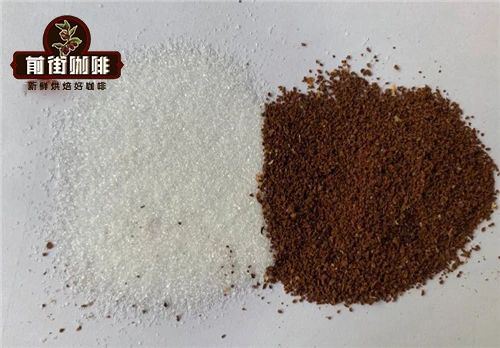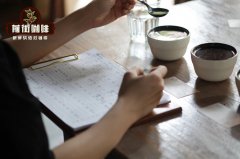How to judge whether the degree of grinding of your chosen coffee is appropriate? How to adjust the grinding degree of hand-brewed coffee powder
"I don't think I'm making this cup of coffee right?"
"how much grinding do you use, please?"
"the size of sugar."

Do you really know the degree of grinding?
Everyone's degree of coffee grinding is not the same, after all, it is a millimeter-level micro-world, it is difficult for us to accurately grasp the appropriate coffee grinding particle size. Therefore, some people began to use analogy to describe the size of coffee particles, the most common analogy is coarse sugar, fine sugar and so on. Indeed, as a daily necessity, everyone knows about granulated sugar, but how many people know the thickness of granulated sugar?
According to the technical requirements of GB 317-2006 white granulated sugar, white granulated sugar can be divided into four levels: refined, excellent, first and second grade. Different grades of granulated sugar are different in purity and particle size accuracy. The granule value of sugar is also divided into coarse grain (0.800~2.50mm), large grain (0.630~1.60mm), medium grain (0.450~1.25mm) and fine grain (0.280~0.800mm), in which the grain is uniform and the particle size should not be less than 80% in the following range.

And we usually use the combination of visual observation and tactile perception, but when this method is applied to experienced people, it will be relatively accurate, but for beginners, it is not very friendly. The ground coffee particles are irregular cubes. Compared with relatively regular sugar crystals, the visual and tactile feedback is different, for beginners, it is easy to grasp inaccurately, when the standard range is larger. Then the analogous coffee powder particle value is also larger.

How to choose the right degree of coffee grinding?
To solve this problem, we must first understand why coffee needs to be ground. Under certain circumstances, the larger the surface area of coffee beans, the more coffee substances are released at the same time. However, the flavor of the substances released by coffee is not all good, so we need to find a suitable grinding degree to extract the flavor substances from the positive side of coffee.

The grinding particle size is also different for different coffee brewing methods. For example, the particle value of espresso and Turkish pot coffee is about 0.2-0.3mm. The best particle value of hand-brewed coffee is 0.6-0.8mm. Although the value is clear, we can't measure it with a ruler. Qianjie suggests using 0.85mm (national standard 20) standard sieve to confirm. Because no matter what the price of the bean grinder, the coffee powder will be coarse and fine, so we hope that the vast majority of coffee powder thickness is in the range of 0.6-0.8mm. So Qianjie coffee uses 0.85mm standard sieve pass rate of 80% as the grinding thickness of medium and shallow roasted coffee beans.

Of course, in addition to the preparation of the data to judge the coffee grinding fineness, we can also judge whether the coffee grinding degree is appropriate according to the coffee brewing process. First of all, the brewing time can have a reference to the grinding thickness, the previous street brewing parameter standard, the normal extraction time of a cup of coffee is about 1 minute 50 seconds to 2 minutes 10 seconds. If the grinding is too fine, the extraction time will be prolonged, and if the grinding is too coarse, the extraction time will be shortened, so that the coffee grinding degree can be judged for the first time according to the extraction time.
The settling velocity of the coffee powder layer during brewing can also be observed. under normal circumstances, the settling velocity of the coffee powder layer decreases slowly and uniformly, if it is found that the falling speed is fast, it may be that the grinding is too coarse, and the settling speed is getting slower and slower, or even clogged. Then it may be that the grinding is too fine or too much fine powder, and the bottom of the powder layer appears muddy.

Of course, the grinding fineness does not have an absolute value, and the grinding degree is only one factor that affects the flavor of a cup of coffee (different brewing methods also have an adjustment range for the grinding degree), and it cooperates with many factors to show a cup of coffee.
Important Notice :
前街咖啡 FrontStreet Coffee has moved to new addredd:
FrontStreet Coffee Address: 315,Donghua East Road,GuangZhou
Tel:020 38364473
- Prev

What is the best drinking temperature for coffee? Why does the coffee taste bad when it is cold?
The freshly brewed coffee is fragrant and rich in flavor. After cooling, it is inevitable that there will be some bad flavors such as wood and almonds. Why is the taste of freshly brewed coffee so different from that of cooled coffee? Lovers of hand-brewed coffee may know that when tasting coffee, you need to taste it at high, medium and low temperatures, and the flavor of a cup of coffee at different temperatures.
- Next

An article asks you to understand the difference between latte, cappuccino and Australian white coffee.
Latte, cappuccino and Australian white coffee are almost permanent categories of milk coffee in coffee shops. This article is to help you distinguish the difference between these three types of milk coffee. As everyone has come into contact with these three kinds of milk coffee more or less, here is a brief introduction to the origin of these three kinds of milk coffee. Modern latte and Cabo
Related
- Beginners will see the "Coffee pull flower" guide!
- What is the difference between ice blog purified milk and ordinary milk coffee?
- Why is the Philippines the largest producer of crops in Liberia?
- For coffee extraction, should the fine powder be retained?
- How does extracted espresso fill pressed powder? How much strength does it take to press the powder?
- How to make jasmine cold extract coffee? Is the jasmine + latte good?
- Will this little toy really make the coffee taste better? How does Lily Drip affect coffee extraction?
- Will the action of slapping the filter cup also affect coffee extraction?
- What's the difference between powder-to-water ratio and powder-to-liquid ratio?
- What is the Ethiopian local species? What does it have to do with Heirloom native species?

